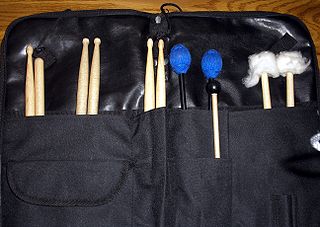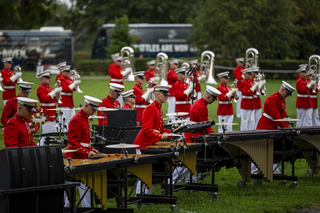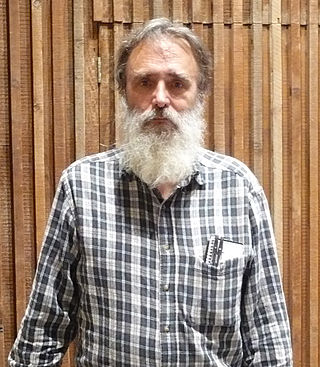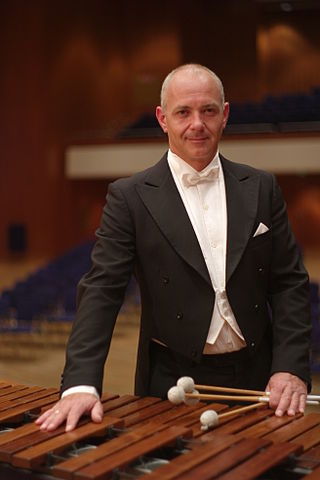
A percussion instrument is a musical instrument that is sounded by being struck or scraped by a beater including attached or enclosed beaters or rattles struck, scraped or rubbed by hand or struck against another similar instrument. Excluding zoomusicological instruments and the human voice, the percussion family is believed to include the oldest musical instruments. In spite of being a very common term to designate instruments, and to relate them to their players, the percussionists, percussion is not a systematic classificatory category of instruments, as described by the scientific field of organology. It is shown below that percussion instruments may belong to the organological classes of idiophone, membranophone, aerophone and chordophone.

The vibraphone is a percussion instrument in the metallophone family. It consists of tuned metal bars and is typically played by using mallets to strike the bars. A person who plays the vibraphone is called a vibraphonist,vibraharpist, or vibist.

A percussion mallet or beater is an object used to strike or beat a percussion instrument to produce its sound.

In a marching band, drum and bugle corps, or indoor percussion ensemble, the front ensemble or pit is the stationary percussion ensemble. This ensemble is typically placed in front of the football field, though some designers may use atypical layouts. Some high school marching bands opt not to march any percussion instruments but instead have a "full" front ensemble.
Orchestral percussion refers to the various percussion instruments used in an orchestral setting. It may also refer to the act of playing such instruments in an orchestral style. Many music schools and conservatories offer training for musicians interested in developing their skills as orchestral percussionists. Typically, an orchestral percussionist does not specialize in one particular instrument. Although there is no exhaustive list of all instruments that an orchestral percussionist must be able to play, there are particular instruments that are frequently used in the orchestral repertoire. This includes timpani, snare drum, bass drum, xylophone, glockenspiel, triangle, and tambourine.
Mitchell Thomas Peters was a principal timpanist and percussionist with the Los Angeles Philharmonic Orchestra. He composed well-known pieces for the marimba such as "Yellow After the Rain" and "Sea Refractions"; it is said that these works were composed because Peters felt that there was a lack of musically interesting material that would introduce his students to four-mallet marimba techniques.

Zyklus für einen Schlagzeuger is a composition by Karlheinz Stockhausen, assigned Number 9 in the composer's catalog of works. It was composed in 1959 at the request of Wolfgang Steinecke as a test piece for a percussion competition at the Darmstadt Summer Courses, where it was premièred on 25 August 1959 by Christoph Caskel. It quickly became the most frequently played solo percussion work, and "inspired a wave of writing for percussion".
Síppal, dobbal, nádihegedűvel (2000) is a song cycle in seven movements by the composer György Ligeti based on poetry by Sándor Weöres. The work is scored for mezzo-soprano and an unusual ensemble of percussion and wind instruments. The lyrics are whimsical and often nonsensical, sometimes combining random Hungarian words or parts of words into a nonsense language.

Stuart Saunders Smith was an American composer and percussionist. After having studied composition and music theory at three music institutions, Smith was currently based in Vermont, United States, with his wife Sylvia. He produced almost 200 compositions, half of which were written for percussion instruments with a focus on the vibraphone.
Douglas William Walter, DMA is Professor of Percussion at the University of Colorado Boulder College of Music, and was the first marimba and vibraphone artist to win a First Prize in the Concert Artists Guild Competition in NYC.

Beat Furrer is a Swiss-born Austrian composer and conductor. He has served as professor of composition at the University of Music and Performing Arts Graz since 1991. He was awarded the Ernst von Siemens Music Prize in 2018.
Luigi Morleo is an Italian percussionist and composer of contemporary music, who lives in Bari and teaches at the Niccolò Piccinni Conservatory.
Pascal Pons, born on 9 November 1968 in Nice, is a French percussionist.

Roland Haerdtner, orig. Härdtner is a German marimba player, a soloist for mallet instruments, percussion and timpani. Since 1993 he is principal timpanist and percussionist of the Badische Philharmonie Pforzheim.
Bob Becker is an American percussionist and composer known primarily as a founding member of the Nexus percussion ensemble, as well as a performer in the Steve Reich and Musicians ensemble. He primarily performs as a keyboard percussionist, but is also skilled in tabla and concert snare drumming. As a composer, Becker employs a multicultural approach by mixing the style of western military drumming with North Indian Hindustani idioms, such as raga scale patterns and tabla drumming. This fusion of compositional practices is the main focus of works like Lahara and Mudra. There are also traces of influence from the music of minimalists like Steve Reich, which can be attributed to Becker's experience with that composer's music.
Emmanuel Séjourné is a French composer and percussionist, and head of percussion at the Conservatoire de Strasbourg. His music is influenced by Western classical music and by popular music.
Matthias Kaul was a German percussionist and composer of classical music.

Michael Waldrop is an American drummer, percussionist, composer and music educator. He is notable as a virtuoso percussionist in both jazz and classical idioms, with equal focus on drumset and keyboard percussion (marimba/vibraphone). Since 2014, he has been a recording artist for Origin Records.
Morris Goldenberg was an American percussionist, music teacher, and method book author. He wrote several books on orchestral snare drumming, mallet percussion, and timpani. He is a member of the Percussive Arts Society Hall of Fame.
Mathias Spahlinger is a German composer. His work takes place in a field of tension between diverse musical influences and styles. Between Renaissance music and jazz; between musique concrète and post-Webernian minimalism; between noise, improvisation, and notation; and between aesthetic autonomy and political consciousness, Spahlinger's works carry out conflicts for which there are no fixed models.









